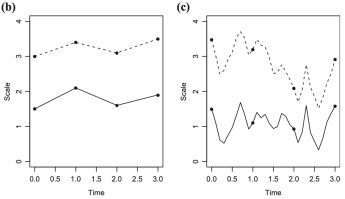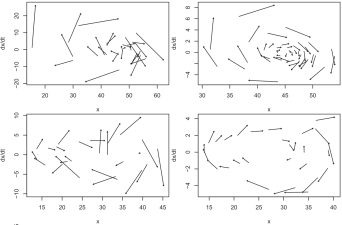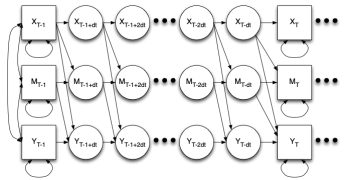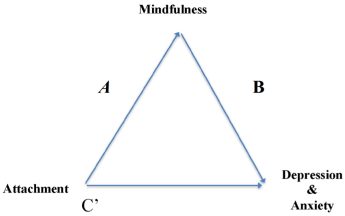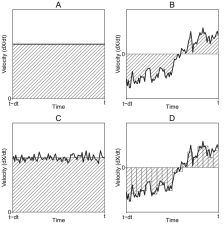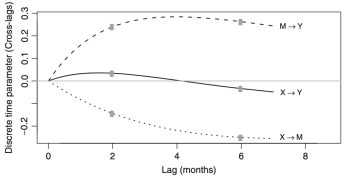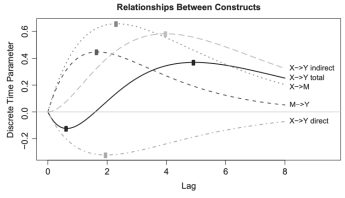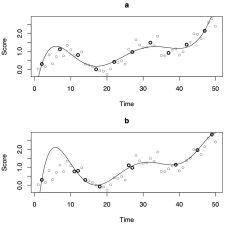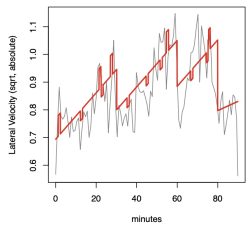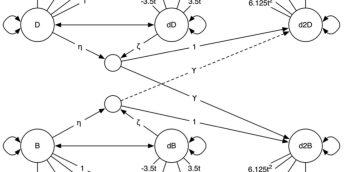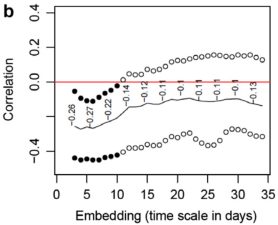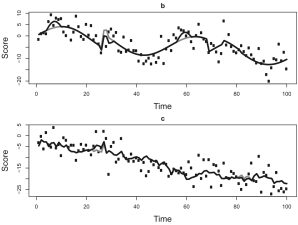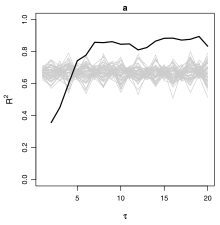Effective interventions may not be limited to changing means, but instead may also include changes to how variables affect each other over time. Continuous time models offer the opportunity to specify differing underlying processes. A substantive example compares models that imply different underlying continuous time processes using panel data.
Category: Uncategorized
Empirical Bayes Derivative Estimates (2020)
This article proposes a new method for estimating derivatives on calculating the Empirical Bayes estimates of derivatives from a mixed model. Two simulations compare four derivative estimation methods: Generalized Local Linear Approximation, Generalized Orthogonal Derivative Estimates, Functional Data Analysis, and the proposed Empirical Bayes Derivative Estimates.
Differing Perspectives on Time Alter Mediation Inferences (2018)
Time is unlike any other variable. This chapter considers the difference in perspectives offered by discrete-time and continuous-time approached to mediation. The differences in how one conceptualizes time have the potential to alter core mediation concepts as direct and indirect effect, complete and partial mediation, and even what constitutes a “mediation” model.
Attachment Changes predicting Depression and Anxiety Changes (2017)
Two studies examined the role short-term changes in adult attachment and mindfulness play in depression and general anxiety.
Dynamical Systems Approaches (2016)
This is an introduction to dynamical systems ideas. Dynamical systems are mathematical models of one or more constructs that change over time. Approaches to dynamical systems are concerned with describing the temporal evolution of constructs, with emphasis often placed on constructs that develop in a complex, nonlinear manner over time.
Integration of Stochastic Differential Equations (2016)
Stochastic differential equation (SDE) models are a promising method for modeling intraindividual change and variability. This method uses structural equation modeling (SEM) conventions to simplify SDE specification, the flexibility of SEM to expand the range of SDEs that can be fit, and SEM diagram conventions to facilitate the teaching of SDE concepts.
Longitudinal Data Analysis (2015)
This essay reviews emerging trends in modeling repeated measures data. Three longitudinal models are discussed: panel model designs, growth curve models, and intensive within-person assessments. Continuous time models for panel data are discussed. The analysis of intensive within-individual observations is also considered, including work that limits the generalizability of interindividual studies to individual outcomes.
No Need to be Discrete: Continuous Time Mediation (2015)
Mediation models based on cross-sectional data can produce unexpected estimates, so much so that making longitudinal or causal inferences is inadvisable. Even longitudinal mediation models produce estimates are specific to the lag between observations, leading to debate over lag selection. Using continuous time models, one can estimate lag-independent parameters.
Dynamical systems and models of continuous time (2013)
Historically, it has been easier to describe differences between groups of people, rather than describe the dynamic ways that people change. This chapter introduces dynamical systems and of continuous time models. Two methods are introduced for the fitting of continuous time models to observed data: the approximate discrete model and latent differential equations.
Gauging Driver Performance (2011)
This paper examines the estimation of derivatives from in-vehicle measures of vehicle control such as steering wheel angle. At very short time scales many in-vehicle measures may indicate characteristics such as fatigue and inattention. This paper models changes in momentary derivative estimates in a 90-minute simulation with 19 participants.
Maternal Depressive Symptomatology and Child Behavior (2011)
This study investigated reciprocal relationships between adolescent mothers and their children’s well-being through an analysis of the coupling relationship of mothers’ depressive symptomatology and children’s internalizing and externalizing behaviors. The present study used dynamical systems to model time continuously, which allowed for the study of dynamic, transactional effects between members of each dyad.
Perceived Emotion Control During Later Life (2011)
The relationship between global emotion control beliefs and daily affect reports across 56 days were assessed in a sample of 298 older adults. Variability analyses investigating multiple time scales revealed global beliefs were related to lower variance in negative affect and less variable speeds of negative affect change across a range of time scales.
Resilience-As-Process: Negative Affect & Stress (2010)
Resilience is often considered both a trait and a process. The current study proposes a new way to conceptualize resilience-as-process based on dynamical systems modeling, which allows researchers to capture the process of stress management in real time using coupled damped linear oscillator models.
Derivative Variability Analysis (DVA) (2009)
Intraindividual measures, such as intraindividual standard deviation or coefficient of variation, are incomplete representations variability. Studying variability can be made more productive by examining specific time scales. Furthermore, examination of variance in observed scores may not be sufficient. A method is introduced that uses estimated derivatives to examine variability at multiple time scales.
Modeling Oscillators Using Surrogate Data Analysis (2008)
Methods for fitting the damped linear oscillator model using differential equation modeling can yield biased parameter estimates when applied to univariate time series. The bias depends on a researcher-selected, smoothing-like parameter. This article explores a technique that uses surrogate data analysis to select such a parameter, thereby producing approximately unbiased parameter estimates.
Mood Oscillations Weather and RCBD (2008)
Rapid Cycling Bipolar Disorder outpatients completed twice-daily mood self-ratings for 3 consecutive months. These ratings were matched with local measurements of atmospheric pressure, cloud cover, and temperature. Several alternative second order differential equation models were fit to the data in which mood oscillations in RCBD were allowed to be linearly coupled with daily weather patterns.
